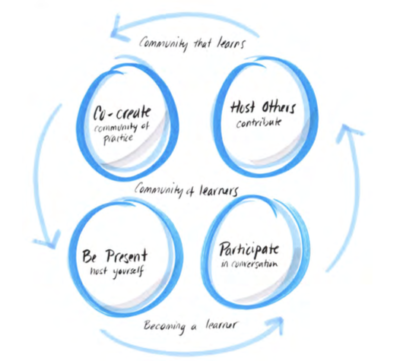
There are some teachings that have impacted me a lot in the last 20 years. That have become foundational for not only what stirs on the surface, but what churns at a molten, magma level. One of these for me, that I find myself returning to lately as I work with core teams, is “The Four Fold Practice” that grew among us in the Art of Hosting community of practitioners.
When I have introduced The Four Fold Practice at workshops, often I’ve referenced it as a curriculum that should be covered over at least two years. Each of its practices, its folds, are worth significant attention, learning, and dwelling with. And, as it is named, it is “practice.” It isn’t something you acquire and then are done (though I suppose this could be more true if thinking at the mastery level of 10,000 hours of practice when it becomes you). It is something you continue to do. And develop. And evolve. And stretch with. Just like cardio-fitness isn’t a one time, or a one week thing either.
Why I’m appreciating this model with core teams is that I’m trying to encourage from the onset the aspect of taking a journey together. Not just a meeting. Not just a series of planning sessions. Not just a single car-ride. It is journey. With unknowns, uncertainties, fears, excitements, questions to linger with, water to draw, food to prepare, and adaptations all along the way.
Here’s the folds in the practice:
Be Present — Showing up is the work. It sounds a bit silly to say such a basic thing. Yet, contemporary society demands much from most of us, doesn’t it. Multi-tasking is a norm (and even a shame if unable to keep up). I know of few people who aren’t required to do twice the work in half the time and with half of the resources. How the globalization pattern of incessantly seeking growth will evolve (or implode) in society is for another day of writing. Suffice it say that there are demands on all of us. And it gives rise, increasingly so, to an ability to practice focus, clarity of purpose, and stillness — both personally and corporally with a group.
Participate — Showing up from a practice of presence (perfection isn’t required), makes a big difference in participation. It’s not passive listening just waiting for the damn meeting to end. It’s not loaded-for-bear confrontation to bully one’s talking points. Presence changes the way that any of us are able to participate in gatherings. Adding in just a bit more ability to listen to what others say, to be curious about each other and ourselves and the many choices of how we approach our task at hand — this matters, right. In my work with The Circle Way, there are three practices that are always encouraged that I find guide participation. Speak with intention. Listen with attention. Tend to the well-being of the group. It’s part of the nuancing of participation, key reminders for all of us.
Host — To participate in society (and communities, and families, and teams) means that you will have your share of stepping in to host. To convene. To create containers so that many people can be in their learning together. Or their imagination. Or their grief. As some of my colleagues have said, “Hosting conversations is both more and less than facilitating. It is an act of leadership and means taking responsibility for creating and holding the ‘container’ in which a group of people can do their best work together.” Hosting does imply some of the basics — a time, a place, chairs, sometimes food. It’s not, however, about passing time. I often think of it as a practice of “activating and animating a composite being.” I think of it as waking up the “we” that is present and yet so illusive, though many of our cultural traditions point us at best to expect, “a collection of me’s.”
Co-Create — This one is the zinger to me. You can see from the above diagram the references to learning, and the evolution from “becoming a learner” to a “community of learners” to a “community that learns.” All of these are important. However, the community that learns, that holds as core identity the practices and habits of paying attention, amplifying curiosity, gathering to listen well together, unleashing creative energy to experiment together, trusting and supporting amidst unavoidable unknowns, uncertainties, and complexities — now that’s something to write home about. Co-creation, that deliberateness — it’s the gold of the journey, scaled. It’s the thing you look back to in 20 years and recognize, that’s when we changed, essentially so, who we were.
Here’s to core teams willing to take the journey. I’m glad to be involved with such good people, committed to holding each other from one point of the journey to the next.
